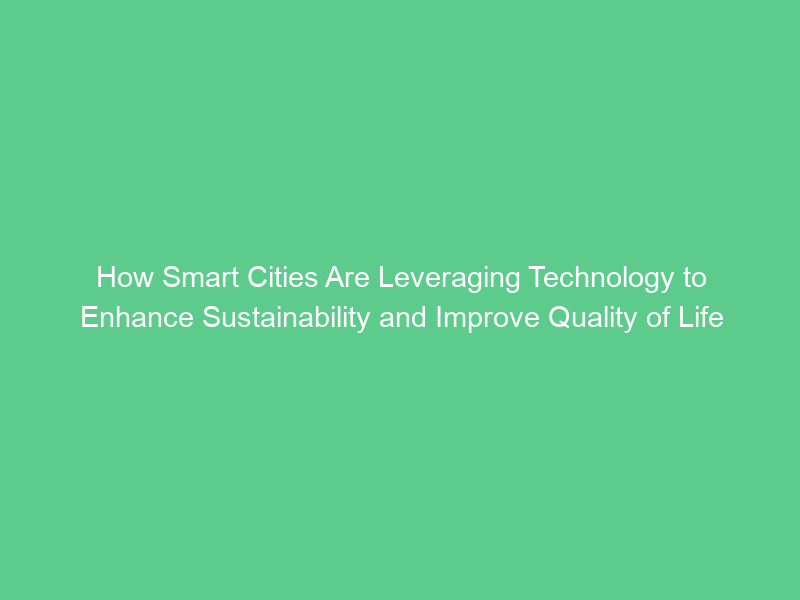Cities around the globe are taking advantage of Smart technology to increase sustainability and enhance quality of life. Cities use pervasive connectivity, open data platforms and software monetization solutions for maximum benefit.
Smart Cities use digital technologies to enhance or create “city services”, which include all the services provided to citizens and businesses alike by their city government.
1. Improved Mobility
Cities around the globe strive to become smartest. While New York City often leads in surveys, other urban centers from Europe to Asia also employ smart technologies in order to optimize residents’ experiences and quality of life.
Sensors offer near real-time awareness of issues needing attention, while local governments adhere to an open data philosophy by regularly sharing operations and planning data with citizens. But smart city solutions require more than technology: they must also be implemented by people themselves.
Imagine driving through an area in which smartphones could show you available parking spots, cutting traffic jams and eliminating waste caused by drivers searching for spots. Or scheduling an autonomous vehicle to pick you up and transport you directly to a doctor appointment – improving mobility for elderly or disabled citizens who cannot use public transit alone.
2. Enhanced Security
Smart city infrastructure can detect threats in real time or predict them in advance, from crime and natural disasters to infrastructure failure.
Artificial Intelligence (AI) software integrated in smart city technologies can scan streams of data continuously for signs of potential threats such as unusual behavior or environmental issues and provide early warning to first responders or citizens as necessary. It then alerts first responders or issues warnings.
Technology also gives the public increased access to information, allowing them to interact directly with government agencies. Text-to-911 and direct data links with 911 enable citizens to request help more rapidly while the infrastructure allows various departments involved with public safety such as police and fire services, EMS services, transportation agencies and others to work more efficiently together in response to incidents, shortening response times and mitigating their impacts.
3. Efficient Energy Use
Smart cities utilise digital technologies to expand and upgrade services that benefit economic, environmental and business needs in an urban area. These might include improving environmental protection or increasing business attractiveness.
Intelligent buildings utilize sensors to monitor occupant energy usage and make adjustments automatically in order to save power without compromising comfort. Intelligent lighting systems may also help cut energy use while waste management solutions reduce consumption by optimizing routes for garbage trucks thereby further decreasing carbon emissions and energy use.
Electric vehicles charged via smart charging stations provide an environmentally-friendly alternative to traditional automobiles, while emergency response response times in life-threatening situations are reduced through priority given to emergency vehicles by smart traffic signals. Smart cities provide many energy saving opportunities – learn more in UNECE publication “People-Smart Sustainable Cities”.
4. Improved Quality of Life
Smart technology enables cities to collect, process and analyze data more efficiently – helping residents benefit from better services provided to them by city officials. For instance, cities might implement apps enabling residents to report potholes or other infrastructure issues directly to them and share traffic pattern details with one another.
Smart systems automate basic services and alert citizens when certain systems require attention (for instance when their trash can is full). This improves quality of life for citizens by decreasing manual work load so they can spend more time with family and friends.
Smart city projects can also help monitor air pollution levels, weather conditions and other elements that impact citizens’ health. Furthermore, such initiatives can offer targeted public health measures like face masks or fever checks for added peace of mind.
5. Reduced Carbon Emissions
By employing green technologies such as renewable energy, smart waste management and more efficient transport, Smart Cities can significantly lower their carbon emissions and combat climate change while simultaneously improving quality of life for residents by decreasing air pollution levels.
Intelligent streets and buildings equipped with embedded sensors and cameras can monitor traffic in real time and report accidents directly to first responders, as well as track air quality, water pollution levels, noise levels, air quality and noise pollution levels in real time – providing city officials with data for optimizing operations, planning and public services.
However, in order for smart city initiatives to be successful they must involve their residents. Citizens must have access to open, democraticized data that allows them to actively take part in shaping and governing their city – encouraging them to adopt smart city technologies and reap its advantages.

